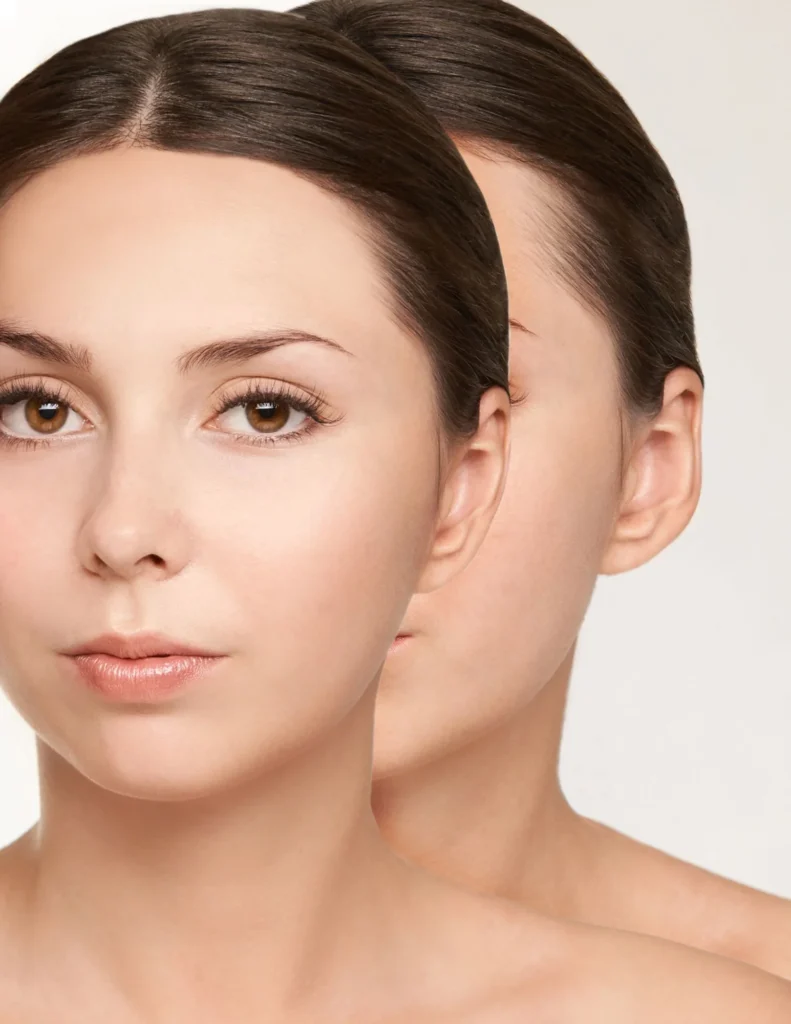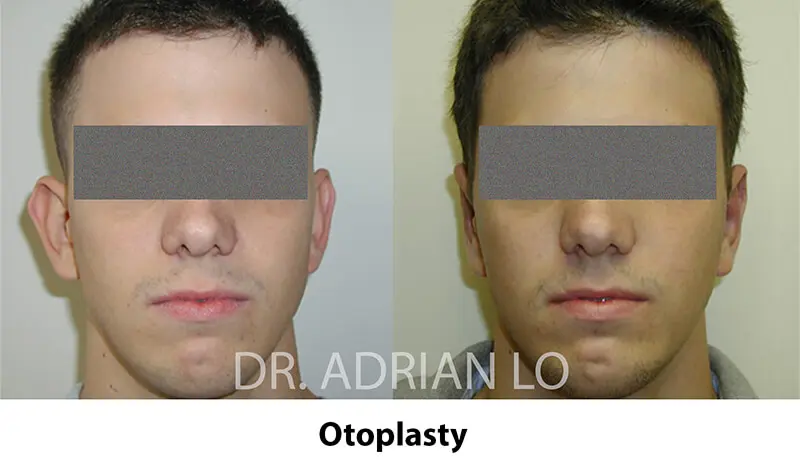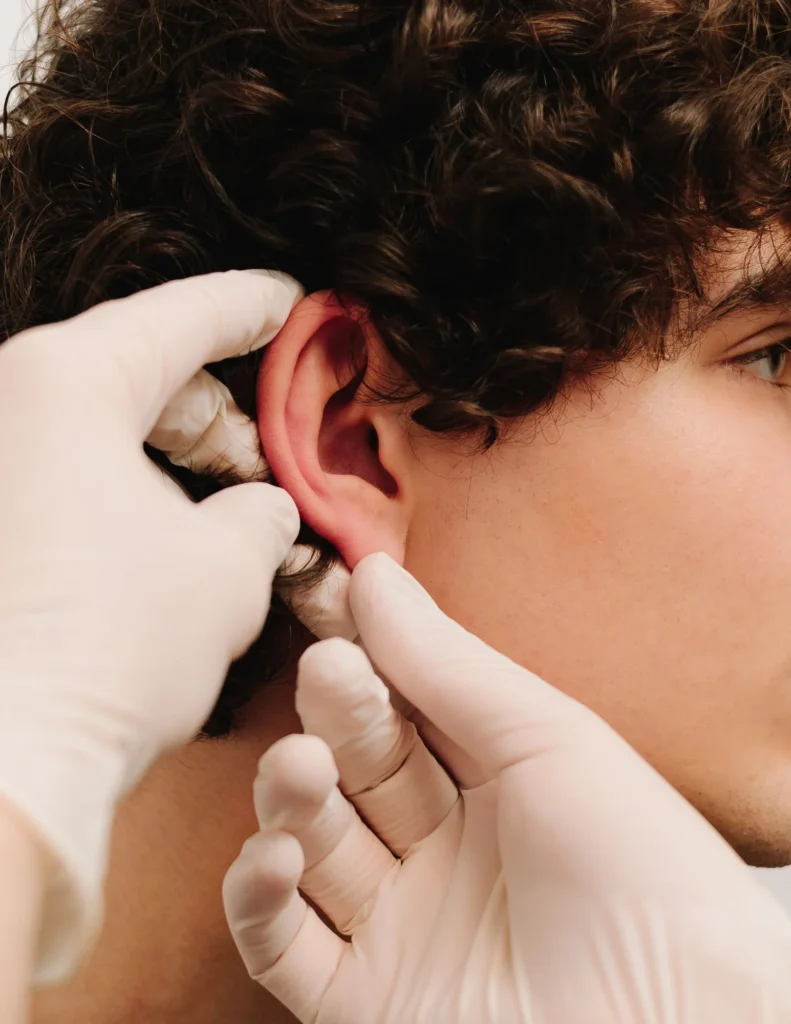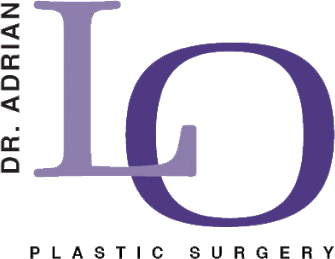The difference between a good otoplasty result and an average one often comes down to what happens after you leave the operating room.
Your otoplasty recovery journey determines not just how quickly you heal, but how beautifully your new ear positioning develops. Following proven aftercare protocols ensures optimal healing while protecting the investment you made in your appearance and confidence.
Most patients worry about the unknown aspects of recovery. Will it hurt? How long before you can sleep normally? When can you return to work or exercise? This comprehensive guide eliminates the guesswork by providing everything you need to know about healing after otoplasty.
From managing your first 48 hours after otoplasty (also known as ear pinning) surgery to confidently resuming all your favorite activities, proper preparation transforms your recovery from an anxious waiting period into an empowering journey toward your aesthetic goals.
Related: How Long is Otoplasty Recovery Time?: A Timeline for Healing
What to Expect During Your Otoplasty Recovery Timeline

Every patient’s otoplasty recovery unfolds uniquely, however, understanding general healing phases helps you prepare confidently. Your individual progress may vary based on your age, overall health, and commitment to following post-operative instructions.
First 24 to 48 Hours Post-Surgery
The immediate post-operative period focuses on comfort management and establishing healthy healing patterns. You will experience manageable discomfort, natural swelling, and possible mild effects from anesthesia during this initial phase.
Your ears will be wrapped in protective head or ear bandages that maintain optimal positioning while healing begins. Most patients describe the sensation as a gentle throbbing rather than intense discomfort. Swelling peaks during the first two days, which temporarily makes your ears appear fuller than expected.
Appropriate rest during this period promotes faster healing. Having a family member or friend stay with you for the first 24 hours ensures proper support and assistance with daily needs while you focus entirely on recovery.
Week One Through Two Recovery Phase
Week one marks active healing as your body repairs the surgical sites. Your plastic surgeon will replace initial bandages with a comfortable headband or sweatband during your first follow-up appointment at 48 hours after otoplasty surgery..
The protective headband safeguards your ears while allowing better visibility of your ear appearance. You must wear this headband/sweatband to maintain your new ear position. Your plastic surgeon will provide instructions on the amount of time the headband/sweatband should be worn during the day. Most patients notice significant comfort improvement by day five to seven.
Swelling decreases noticeably during the second week, revealing more of your new ear shape. Natural puffiness around the surgical sites is normal throughout this period. Your ear skin may appear slightly red which is normal and not a sign of infection. Your energy levels will steadily improve, preparing you for gradual activity increases.
Long-Term Healing Over 4 to 6 Weeks
Complete otoplasty recovery time extends four to six weeks, with improvements continuing for several months. By week 1, most patients confidently return to desk jobs and light activities usually begin on week 2.
Your final ear positioning becomes apparent around week 4, though minor natural swelling and redness may continue for several more weeks. Your surgical sites will be healed by this point, appearing as thin lines behind your ears.
Full activity clearance typically occurs at the eight-week mark, allowing you to confidently resume contact sports and other high-impact activities. Your plastic surgeon will provide personalized clearance based on your individual healing and specific procedure details.
How to Manage Pain and Discomfort After Ear Surgery

Effective comfort management during ear surgery recovery ensures your wellbeing while promoting optimal healing. Most patients find post-operative discomfort very manageable when following appropriate protocols and comfort-enhancing measures.
Pain Relief Medication Guidelines and Timing
Your plastic surgeon will recommend non-narcotic medications to manage post-operative discomfort. Take medications as prescribed, maintaining consistent timing to prevent discomfort from intensifying unnecessarily during the first 48 hours.
Pain medications should be used as necessary as the discomfort from ear surgery is usually minimal. Over-the-counter medications like acetaminophen or ibuprofen is all that is usually required.
Always follow recommended dosages and avoid combining medications without your plastic surgeon’s approval. Keep a medication log to track timing and effectiveness, which can help identify optimal dosing schedules for your specific recovery needs.
Cold Compress Application Techniques
Cold compresses effectively reduce otoplasty swelling and bruising when applied correctly during the first 24 to 72 hours. Use ice packs wrapped in thin towels, never applying ice directly to your skin.
Apply cold compresses for 15-20 minutes at a time with equal rest periods between applications. Focus on areas around your ears rather than directly over the surgical sites to avoid disturbing your bandages or healing progress.
Frozen peas or gel ice packs work well because they conform naturally to the contours around your ears. Transition away from cold therapy after the third day, as your body’s natural healing processes take over effectively.
Natural Pain Relief Methods That Actually Work
Several natural approaches complement medications for comprehensive comfort management. Elevation of your head while resting reduces excessive blood flow to the surgical area, minimizing any throbbing sensations naturally.
Deep breathing exercises and meditation help manage discomfort perception while promoting relaxation and better sleep quality. Gentle neck stretches, approved by your plastic surgeon, can relieve tension that contributes to overall discomfort.
Staying well-hydrated supports your body’s natural healing processes and helps prevent headaches that can affect overall comfort. Completely avoid alcohol during recovery, as it interferes with medication effectiveness and optimal healing.
Why Proper Wound Care Prevents Complications
Excellent wound care during healing after otoplasty prevents complications while ensuring optimal scar formation. Your plastic surgeon will provide specific instructions for cleaning and caring for your surgical sites throughout the recovery process.
Daily Cleaning and Dressing Change Protocol
Always clean your hands thoroughly before touching your ears or changing any dressings. Use gentle, fragrance-free soap and lukewarm water when cleaning becomes permitted, typically after the first week post-surgery.
Pat the area dry with clean paper towels rather than cloth towels that may harbor unwanted bacteria. Apply any prescribed ointments or medications exactly as instructed, using clean cotton swabs to maintain product purity.
Change or wash protective headbands/sweatbands regularly never leaving soiled or wet materials against your healing skin. Keep extra supplies readily available to maintain optimal hygiene throughout your recovery journey.
Signs of Infection You Should Never Ignore
Monitor your surgical sites daily for any changes that require immediate professional attention. Increasing redness, warmth, or swelling around the sites may indicate developing complications requiring prompt care.
Fever above 101°F, especially when accompanied by chills, suggests possible infection requiring immediate treatment. Any unusual drainage (eg. white pus) from the surgical sites, particularly if it becomes thick, colored, or unpleasant-smelling, warrants immediate contact with your plastic surgeon.
Persistent or increasing discomfort that does not respond to pain relief medications may signal complications beyond normal healing processes. Marked redness with tenderness at and beyond the surgical site may indicate an infection and should be evaluated by your plastic surgeon.
When to Contact Your Plastic Surgeon Immediately
Certain symptoms during recovery demand immediate professional attention regardless of timing. Severe, sudden discomfort that differs significantly from your baseline post-operative experience should prompt immediate contact.
Significant bleeding that saturates multiple layers of bandages requires urgent evaluation and treatment. Any signs of allergic reaction to medications, including rash, breathing difficulties, or facial swelling may constitute medical emergencies.
Never hesitate to reach out with questions or concerns during your recovery period.
How to Sleep Comfortably During Otoplasty Recovery
Quality sleep promotes healing while managing discomfort, making proper sleeping after ear surgery arrangements essential for recovery success. Restful sleep requires specific positioning and environmental modifications for optimal comfort and healing.
Best Sleep Positions to Avoid Ear Pressure
Sleep exclusively on your back for the first two to three weeks post-surgery to completely avoid putting pressure on your healing ears. Side sleeping should be avoided as it can cause pressure on the ears.
Use a reclining chair or adjustable bed when available, as the elevated position reduces swelling while maintaining proper back-sleeping posture. When using a regular bed, stack multiple pillows or a special wedge pillow to create a comfortable incline that keeps your head properly elevated.
Stomach sleeping should be avoided during recovery, as this position also puts pressure on your ears and can disturb protective bandages. Many patients find travel pillows helpful for maintaining back-sleeping position throughout the night.
Pillow Arrangements for Maximum Comfort
Create supportive pillow arrangements around your body to prevent rolling onto your sides during sleep. Place pillows along both sides of your torso and legs to maintain your back-sleeping position.
Use a cervical support pillow or rolled towel under your neck to maintain proper alignment while keeping your head elevated appropriately. Avoid overly soft pillows that allow your head to flex, as this can reduce elevation and potentially result in increased swelling.
Consider using a wedge pillow designed for post-surgical recovery, as these provide consistent elevation and support throughout the night. Memory foam pillows work well for maintaining head position while providing comfortable support for extended periods.
Creating an Optimal Sleep Environment
Maintain a cool, comfortable room temperature to prevent excessive sweating that could affect your bandages or healing sites. Use blackout curtains or eye masks to promote better sleep quality despite any temporary discomfort.
Keep water, medications, and tissues within easy reach to minimize movement during the night. A small lamp or nightlight helps you navigate safely for necessary trips without fully awakening.
White noise machines can help mask household sounds that might disturb your rest. Avoid electronic devices before bedtime, as blue light can interfere with natural sleep patterns your body needs for optimal healing.
Activities to Avoid During Healing
Activity guidelines during recovery protect your healing ears while ensuring the best possible final results. Understanding which activities to modify helps you make informed decisions throughout your healing journey.
Exercise and Physical Activity Restrictions
It is necessary to avoid all strenuous exercise for the first two weeks post-surgery, including running, weightlifting, and high-intensity workouts. These activities can increase blood pressure and heart rate, potentially promoting swelling or bleeding.
Light walking is encouraged immediately to promote healthy circulation and prevent blood clots. However, avoid any activities that cause bouncing or jarring motions that could affect your healing ears.
Yoga and stretching exercises when allowed to resume in 3 to 4 weeks require temporary modification to avoid positions that lower your head below your heart. Inverted poses, forward bends, and other head-down positions can increase blood flow to your ears unnecessarily.
Work and Daily Life Limitations
Most patients successfully return to desk jobs within one week, provided they can maintain proper head positioning and avoid activities that risk ear contact. However, jobs requiring physical labor or protective headgear require longer temporary restrictions.
Driving clearance depends on your ability to safely turn your head and react quickly without discomfort or distraction from protective bandages. Most patients can drive comfortably within one week, but timing varies from individual to individual.
Hair washing requires assistance or modification to keep bandages and surgical sites properly dry. Avoid hair salons and professional styling until your plastic surgeon clears normal hair care activities, typically after three to four weeks.
Social Activities and Travel Considerations
Temporarily postpone social events and gatherings where accidental trauma to your ears could occur during the first two weeks of recovery. Crowded environments pose unnecessary risks of bumps or contact that could affect healing.
Air travel requires special consideration due to pressure changes and limited ability to elevate your head properly. Most plastic surgeons recommend avoiding flights for at least two weeks post-surgery unless absolutely necessary.
Swimming pools, hot tubs, and other bodies of water must be completely avoided until your sites are fully healed and you receive specific clearance from your plastic surgeon. Water exposure creates unnecessary infection risks and healing complications.
How to Minimize Swelling and Bruising
Reducing otoplasty swelling and bruising accelerates your recovery while improving your comfort throughout the healing process. Specific dietary approaches, positioning strategies, and supplement protocols can significantly enhance your recovery experience.
Dietary Changes That Support Healing
Increase your protein intake to provide essential building blocks for tissue repair and healing. Lean meats, fish, eggs, and plant-based proteins support optimal recovery when consumed consistently throughout your healing period.
Reduce sodium intake significantly to minimize fluid retention that contributes to swelling. Focus on fresh, whole foods that naturally support healing processes while avoiding processed foods and added salt.
Stay well-hydrated by drinking plenty of water throughout the day, as proper hydration helps your body process swelling more efficiently. Limit caffeine and completely avoid alcohol, as both can interfere with healing and potentially increase swelling.
Elevation and Positioning Strategies
Maintain head elevation above heart level as much as possible during the first week post-surgery. This positioning uses gravity to reduce blood flow to your ears, naturally minimizing swelling and promoting drainage.
Sleep with your head elevated on multiple pillows or in a reclining chair for the first two weeks. Even during daytime rest periods, choose elevated positions over lying flat to maintain consistent swelling reduction.
Avoid bending over or lowering your head below your heart level for any activities during the first two weeks. Use tools with extended handles for tasks that normally require bending, or request assistance with low-level activities.
Supplements and Treatments That Help Recovery
Arnica supplements, when approved by your plastic surgeon, may help reduce bruising and swelling during recovery. However, never start any new supplements without specific approval from your plastic surgeon, as some supplements can interfere with healing or medications.
Vitamin C supports collagen production and wound healing when taken in appropriate doses. Your plastic surgeon may recommend specific dosages based on your individual needs and overall health status.
Discuss all potential supplements with your plastic surgeon before adding them to your recovery regimen to ensure safety and effectiveness for your specific healing needs.
When to Resume Normal Activities After Otoplasty

Gradual return to normal activities prevents complications while allowing you to regain your regular lifestyle safely. Your otoplasty aftercare tips include timelines for different activity types based on healing progress and safety considerations.
Returning to Work and Professional Duties
Desk jobs typically allow return within one week, provided you can maintain proper positioning and avoid activities that risk ear contact. However, jobs requiring helmets, headphones, or other ear equipment require longer temporary restrictions.
Professional presentations and client meetings become manageable after the first two weeks when protective headbands are no longer needed. Plan accordingly by scheduling important meetings after your initial recovery period when possible.
Remote work options provide excellent flexibility during early recovery, allowing you to maintain productivity while following all positioning and activity guidelines necessary for optimal healing success.
Exercise and Sports Activity Guidelines
Light cardiovascular exercise like walking can resume within one week, gradually increasing intensity as your comfort allows. However, temporarily avoid any activities that cause significant sweating or require protective headgear during the first month.
Weightlifting and resistance training require clearance from your plastic surgeon, typically around three to four weeks post-surgery. Start with lighter weights and avoid exercises that strain your neck or require lying flat.
Contact sports and activities with injury risk require full clearance at eight weeks minimum. Sports like football, wrestling, or martial arts pose unnecessary risks to your healing ears and surgical results.
Swimming and Water Activity Restrictions
Swimming pools, oceans, lakes, and hot tubs remain temporarily off-limits until your plastic surgeon provides specific clearance, typically six to eight weeks post-surgery. Water exposure creates unnecessary infection risks through healing sites.
Showering requires careful protection of your ears and bandages during early recovery. Use waterproof covers or request assistance with hair washing to keep surgical sites completely dry.
Water sports and activities like surfing, water skiing, or diving require additional clearance from your plastic surgeon beyond basic swimming approval due to increased risk of ear contact from water pressure and impact.
Experience Professional Otoplasty Ear Pinning Surgery with Dr. Adrian Lo
Your successful otoplasty recovery starts with choosing the right plastic surgeon who prioritizes both exceptional results and comprehensive aftercare support.
Dr. Adrian Lo transforms ear surgery experiences by providing personalized otoplasty pain management protocols and detailed recovery guidance throughout your entire healing journey. His meticulous surgical techniques combined with proven aftercare methods ensure optimal healing and beautiful, natural-looking results that enhance your confidence for years to come.
As an award-winning plastic surgeon, Dr. Lo recognizes that successful otoplasty recovery depends on detailed guidance, ongoing support, and immediate access to expert care when needed. His Philadelphia plastic surgery practice maintains convenient locations in both Philadelphia and New Jersey, ensuring patients receive world-class care close to home.
From your initial consultation through complete recovery and beyond, Dr. Lo and his experienced team provide the expertise, attention, and personalized care necessary for achieving your aesthetic goals safely and effectively.Ready to begin your transformation with confidence? Schedule a consultation today to discover how Dr. Lo’s proven otoplasty planning and comprehensive recovery support can help you achieve the natural, beautiful ear positioning you have always desired.
